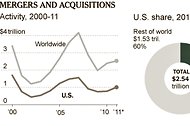In Madrid, the Treasury said it sold €10 billion, or $12.7 billion, of bonds in total — twice the targeted amount — with yields falling about 1 full percentage point from previous auctions.
The Italian Treasury allotted all of the €8.5 billion of the 12-month bills it had targeted for sale, with its yields falling by half or more.
Both Spain and Italy are under intense pressure from investors because of their public finances, with recently installed governments scrambling to push through additional austerity packages to rein in deficits and debt levels.
The European Central Bank’s decision last month to aid struggling euro zone banks with longer-term refinancing operations has taken some of the heat off in recent weeks.
The E.C.B. is providing unlimited three-year credit on easy terms to banks, against a wide range of collateral. That has helped to reduce stress in the credit markets, and some say, could ease the so-called “refinancing hump” that euro zone governments face this year, under which they must roll over hundreds of billions of euros of maturing debt.
Harvinder Sian, a bond strategist at Royal Bank of Scotland in London, said the Spanish sale “went very well” and should cover about one-tenth of Spain’s borrowing needs for 2012.
Considering that the initial target of €5 billion was already a significant amount, he said, the fact of a €10 billion total issue “is almost unprecedented, to my mind.” Still, he said, there is a question about how much to read into the results, as “it’s hard not to see it as being a bit stage-managed.”
The solid showing by both countries on Thursday pushed down yields for 10-year bonds on secondary markets, although they remained at levels considered unsustainable by analysts in the medium and longer term.
The yield on Spanish 10-year bonds dropped to 5.1 percent, while Italy’s slid to 6.5 percent. German Bunds, the euro zone benchmark, were relatively unchanged at 1.8 percent.
In the auction Thursday in Madrid, the three-year bonds, which accounted for €4.3 billion, were sold at an average yield of 3.75 percent, compared with 4.87 percent at the previous auction of such bonds in July. Another €4.3 billion of a new three-year bond sold at a yield of 3.38 percent.
The Spanish Treasury also sold €3.2 billion worth of a bond maturing Oct. 31, 2016 for 3.91 percent, compared with 4.85 percent last November.
The 12-month bills sold by the Italian government were priced to yield 2.79 percent — down sharply from the 5.95 percent it paid to sell similar securities on Dec. 12.
Italy also sold €3.5 billion of three-month bills priced to yield 1.64 percent, down from 3.25 percent at the last auction.
Italy was hoping to sell another €4.75 billion of debt Friday.
David Jolly reported from Paris.
Article source: http://feeds.nytimes.com/click.phdo?i=8aaf4bc2b98d451460743a7ed0d47efd



